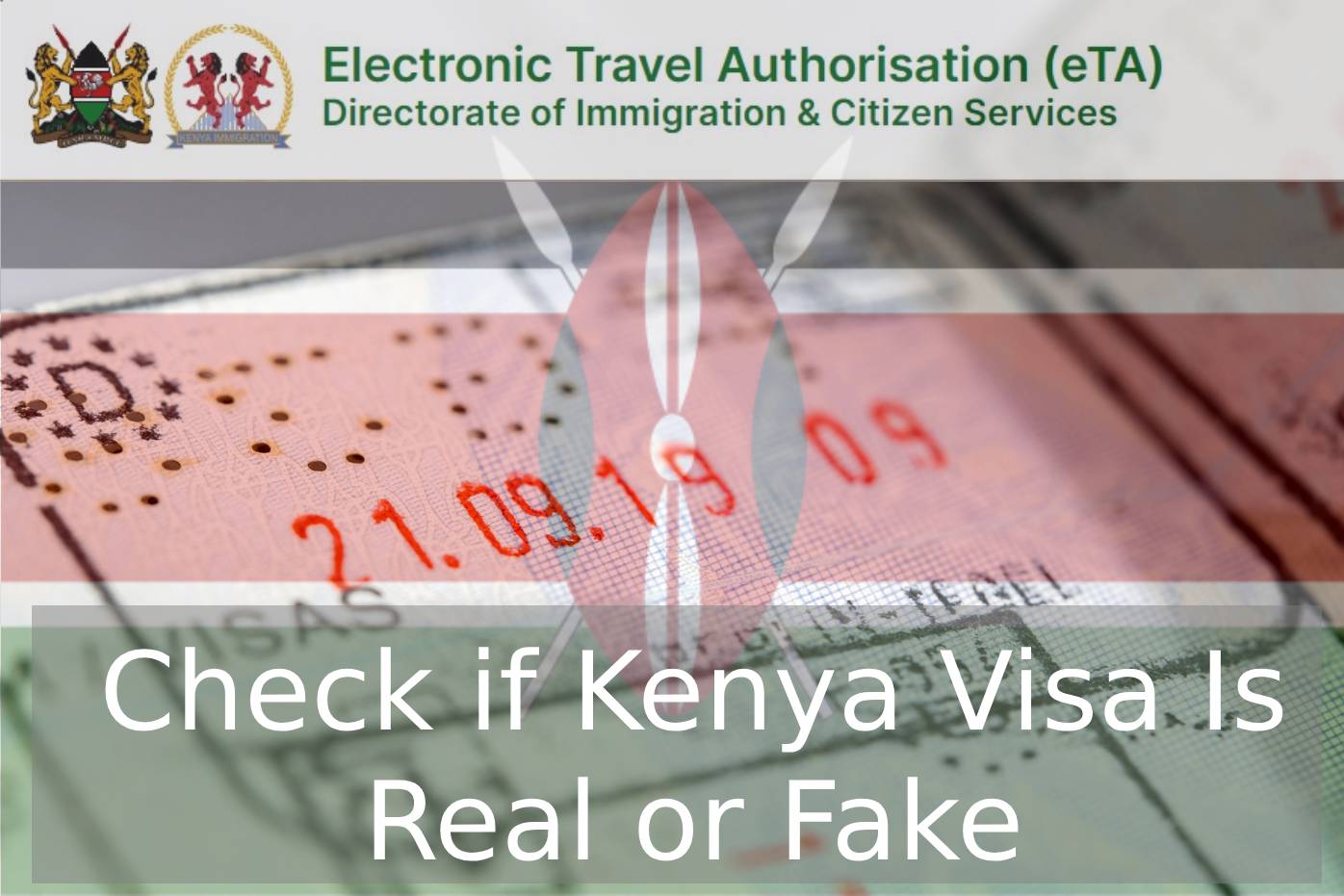Check if Kenya Visa Is Real or Fake

Determining whether a Kenya visa is real or fake involves verifying its authenticity through various methods.
This process includes checking for security features such as watermarks, holograms, and UV-sensitive elements that are embedded within legitimate visas.
It is not possible to enter Kenya without a valid visa or ETA. Therefore, all travelers must apply beforehand. The exemption applies only to citizens of Burundi, DR Congo, Rwanda, South Sudan, Tanzania, and Uganda.
Kenya eTA is a single-entry visa that can be issued for tourism and business. In this case, the validity and permitted stay is 90 days.
Visa verification is not just a procedural step; it’s a vital part of planning your international travel. Travelers must have a Kenya visa to enter the country legally.
It proves you can enter Kenya for a specific purpose, whether for tourism, business, or transit.
Failure to verify your visa could lead to serious legal consequences and disrupt your travel plans.
NOTE: Always verify your visa well before your departure date to avoid last-minute issues.
Common Indicators of Fake Visas
Fake visas are alarmingly prevalent and can be difficult to spot.
Knowing what to look for can save you from becoming a victim of visa fraud.
Common indicators include poor-quality paper, incorrect fonts, misspellings, and inconsistent information.
Key features to look for in a genuine visa include:
- Official security features such as watermarks or holograms
- Accurate personal information matching your passport
- Clear and professional printing
NOTE: If something about your visa seems off, always seek confirmation from a reliable source.
How to Check Kenya Visa Validity on the Official Website
You can check your Kenya eTA validity on the official website of the Ministry of Interior and National Administration: https://www.etakenya.go.ke/en/retrieve-application.
To verify the status of your existing application, visit the website and follow the steps below:
- Enter your passport number
- Choose your date of birth
- Provide the application reference number (or additional passport details)
- Click “Check the status”
- Review the presented information.
If your Kenya visa application is not found, thoroughly check whether you provided all the details correctly. Any typo can cause issues in that matter, so make sure that you don’t substitute letters with numbers and vice versa.
Real vs. Fake Visas
To help you spot a fake visa, compare it with images of official visas.
Look for discrepancies in the color, texture, and design elements.
Official images are often found on government websites.
NOTE: Use a magnifying glass or digital zoom to inspect the finer details on your visa.
What are the Security Features of the Kenya Visa?
Once you receive the eTA Kenya approval, you must examine your document to see if it is genuine.
A real Visa to Kenya contains the official Commonwealth Coat of Arms and security features, such as a unique reference number and a QR code.
The further information that must be present in the Kenyan visa includes:
- Applicant’s first and last name
- Applicant’s date of birth
- Travel Authorization type
- Applicant’s passport number
- Applicant’s nationality
- Start validity date
- Date of visa expiry
- Allowed number of entries
- Purpose of visit
What should I do if I suspect my Kenya visa is fake?
If your Kenya visa seems to be counterfeit, you need to request verification from the Kenyan authorities. Contact the nearest embassy or consulate.
Alternatively, you can use the official website of the Ministry of Interior and National Administration, State Department for Immigration and Citizen Services, Directorate of Immigration Services to check your Kenya visa online.
Make sure you verify your eTA to Kenya soon enough. If your visa turns out to be fake, you will still have time to apply via a secured source.
Common Mistakes That May Indicate Fraud
Visa applications are prone to errors, and fraudsters take advantage of these mistakes.
Common errors include misspelled names, incorrect passport numbers, and inaccurate travel details.
These mistakes can lead to a fake visa being issued without your knowledge.
NOTE: Review every detail on your visa application carefully before submission to avoid fraud.
How These Mistakes Can Be Exploited by Fraudsters
Fraudsters often exploit application errors by issuing counterfeit visas.
They might offer ‘urgent processing’ for a fee, using incorrect details to produce a fake document.
Being aware of these tactics can help you spot and avoid scams.
NOTE: Never pay for visa services outside of official channels.
Recent Changes in Visa Policies and Their Impact
Visa policies are constantly evolving.
Recent changes include the introduction of electronic travel authorizations (eTA) and new visa waivers.
It’s essential to stay updated on these changes as they affect visa verification processes and requirements.
Implications for Travelers Regarding Verification
With the shift to electronic visas, verification processes have become more digital.
Travelers must adapt by learning how to utilize online verification systems effectively.
This reduces the risk of fraud and simplifies travel preparations.
NOTE: Familiarize yourself with e-visa processes to ensure compliance with current policies.
Legal Consequences of Holding a Fake Visa
Holding a fake visa can lead to severe legal consequences.
Penalties may include fines, deportation, or a ban from entering Kenya in the future.
Understanding these risks underscores the importance of proper verification.
NOTE: Always prioritize acquiring a legitimate visa to avoid legal troubles.
Potential Penalties and Legal Actions
Legal actions against holders of fake visas can be swift and severe.
Authorities may detain you for questioning, impose heavy fines, or take further legal action.
Compliance with immigration laws is non-negotiable for international travelers.
NOTE: Retain all documentation related to your visa for verification purposes.
Conclusion
Verifying your Kenya visa is a critical step in ensuring a smooth and safe travel experience.
By understanding common fraud indicators, utilizing official verification methods, and adhering to legal requirements, you can protect yourself from the consequences of a fake visa.
Stay informed about recent policy changes and leverage reliable sources for travel advice.
Sources:
https://www.etakenya.go.ke/en/retrieve-application

Hi, I’m Caroline Kimani. Born and raised in Kenya, I’ve spent over a decade working within the Kenyan immigration department, specializing in passport and visa issues. My experience has afforded me a unique insight into the intricacies of immigration procedures and the challenges applicants face. Passionate about helping others navigate these processes with ease, I’ve dedicated myself to providing valuable information to streamline the journey for fellow Kenyans and visitors alike.